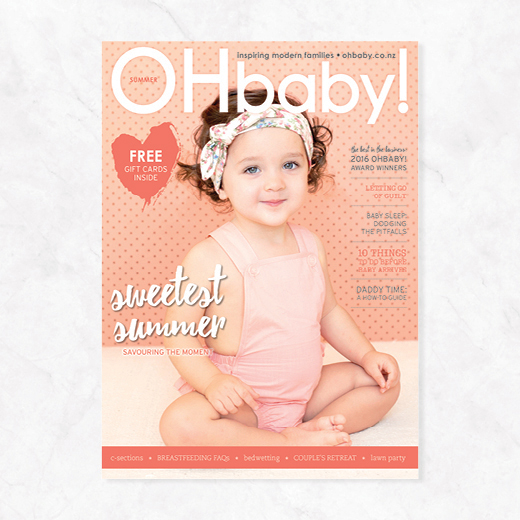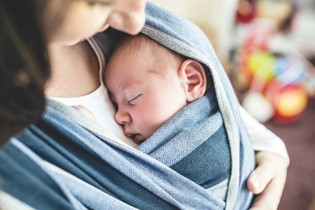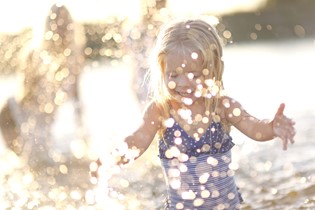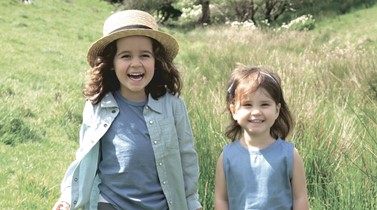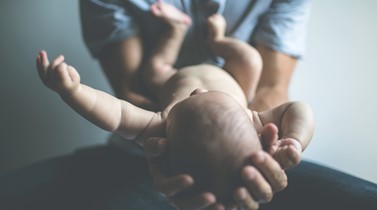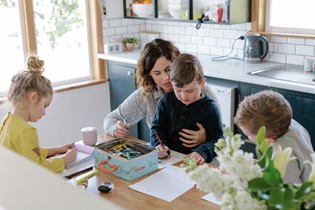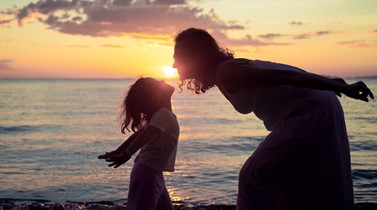Keys to keeping our kids safe

It’s not the easiest topic to chat about, but keeping our kids safe is undeniably worth our attention. Sarah Tennant talks tactics.
Recently my five-year-old was playing in the park that backs onto our garden. I was keeping a vague eye on him as I weeded, and saw him run up to a young couple with a dog and engage them in long-winded conversation, as he does.
When he eventually returned, I said “I see you made some new friends”. “Yep!” he said. “But it's okay. I asked them if they were thieves and if they were going to steal me, and they laughed and said no.”
Which goes to show that I am eminently qualified to write an article on child safety.
BEYOND STRANGER DANGER
Back when I was small enough to abduct, the buzzword was 'stranger danger'. No longer! The New Zealand Police website bluntly refers to stranger danger as “an outdated, discredited and potentially dangerous concept”; and they have good reasons for saying so.
Firstly, it's just not true that strangers are the source of most danger. The whole 'kids being spirited away by a mysterious trench-coated man' scenario is vanishingly rare. Most abuse is by acquaintances, friends and family members. Although the infrequent child-snatching case is seared into public consciousness by media exposure, they're really not as common as we think. (Same goes for shark attacks, if that's been keeping you up at night.)
Secondly, teaching nervously-inclined children that strangers are dangerous can cause them needless paranoia. My friend Hannah spent her childhood in constant fear of kidnapping, despite the unlikelihood of that happening. To be fair, kids aren't rational – I spent my childhood in constant fear of orca whales – but an overemphasis on stranger danger can give anxious children a worry that really isn't warranted. It might even prevent them seeking help in a dangerous situation – sometimes, you should talk to strangers!
Thirdly, and most importantly: most children don't have a clue what a stranger actually is! An Australian study of five-to-eight-year-olds involved quizzing the children on safety issues. The author discovered “...the children had been indoctrinated with a fear of dangerous strangers but their definitions of ‘stranger’ were alarming in their inaccuracy. All strangers were thought to be male, dangerous and readily identifiable by their evil leer, their ugliness, staring eyes and dark apparel. All of the children assured the researchers that they had never seen a stranger in their lives (other than on television) and they would recognise one instantly if they saw one. They claimed that the researcher was not a stranger because ‘you have a job – you’re carrying a briefcase and strangers don’t do jobs’. Strangers were never female and ‘strangers would never be allowed in school’”. I can attest to that. My children say “I made a friend!” about a kid they met five minutes ago at the park. Sometimes they invite them to their next birthday party – you know, eight months from now. Expecting them to accurately categorise people, Facebook-style, as 'close friends', 'acquaintances' and 'strangers'? Not gonna happen.
Furthermore, from the same study: “Virtually all five-year-olds would accompany strangers who appeared to be friendly and kind. These children were unable to judge adults’ motives. Their judgements were based entirely on appearance: people who seemed ‘nice’ and looked kind were deemed to be kind”.
I can attest to that too. My daughter and I have had a lifelong dialogue about her habit of declaring television characters – and occasionally people in real life – 'nice', when what she really means is 'pretty'. My insistence that looking nice and being nice are separate things has yet to sink in; in fact, she straight-up doesn't believe me. (Equating beauty with virtue is called the halo effect, and adults aren't immune to it either, so perhaps it's a lost cause.)
But if 'stranger danger' is out, what do we do instead? One solution comes from Pattie Fitzgerald, a safety expert who's written two books for children: No Trespassing – This Is MY Body! and Super Duper Safety School. Fitzgerald teaches safety based on the concept of 'tricky people'. It's a quietly brilliant concept. Instead of teaching kids to beware of people based on how well they know them, it teaches them to beware of anyone – stranger, babysitter, neighbour, teacher, friend – who behaves in a 'tricky' way.
'TRICKY' BEHAVIOUR INCLUDES THINGS LIKE:
■ Adults asking children for help (safe adults would tend to ask another adult)
■ People telling children to keep secrets from their parents
■ People wanting to play with children with the door closed
It's not hard to teach children the concept of 'trickiness', emphasising that anyone can be tricky – even adults, even relatives – and that trickiness should be called out or reported on. It can be handy to teach children stock phrases to use in 'tricky' situations: things like “No thanks, we keep the doors open in this house” or “We don't get in anyone's car without asking Mum".
DODOS VS MEERKAT
Pondering this approach, I realised I'd been thinking about safety all wrong. If I'd had to nominate one child as 'Most Likely To Be Abducted', it would have been my son – the happy-go-lucky, extroverted, naïve kid who once told me I didn't need to worry about him being 'stolen', because he would just "shoot the bad guys with my bow and arrow and run really fast, like the Flash!".
He reminds me, and I say this with love, of a dodo – friendly, cheerful and unsuspecting enough to practically walk into the cooking pot. And certainly, I can imagine my son hopping into a stranger's ice-cream truck with nary a moment's thought. But here's the thing: no self-respecting child predator would come within ten feet of him. And the reason is precisely because he's so fearless. An unquenchable, chatty child like that would be a nightmare to abduct – he'd tell the guy at the petrol station “This man's taking me for a ride without Mummy!”.
And indeed, when we went to LA for a holiday and came across a naked homeless man down the side street, who was the one saying loudly “Look, that man's naked!”? No stigma and secrets there. Even his “Are you thieves?” to the couple in the park isn't a terrible tactic, really – if I'd been planning to steal a child and he asked that, I'd probably look further afield!
So perhaps the kids who run up and hug random strangers in the supermarket aren't the ones we should worry about. Social fearlessness is protective, not dangerous. Perhaps, instead, we should worry about the quiet, shy, skirt-clinging child. The one who respects authority, is obedient, and doesn't like to make a fuss or be the focus of attention. The one who's more like a meerkat than a dodo – skittish and nervous.
It's easy to think that a child like that is immune to predators because she's too shy to approach anyone, or because she's always with you. But these are the kids we need to coach to stand up for themselves. We need to emphasise to them, over and over again, that it's not rude to say 'no' to something that makes you uncomfortable, even if it's an adult asking; that it's not rude to tell Mummy about a rude thing someone else did; and that they don't need to accept sloppy kisses from relatives if they don't want to.
GETTING LOST
So, the good news is your child probably won't be snatched from his cradle. The bad news is the likelihood of him getting lost one day at the supermarket/park/shopping mall approaches 100%. Getting lost – or stranded - happens. Every family has the story of Dad forgetting to pick Sarah up from music lessons, or the time the van was ten minutes down the highway before someone realised Child #5 was still in the petrol station bathroom.
It's almost inevitable: so do your kids know what to do when it happens? Obviously prevention is better than cure; and the best anti-child-losing tips I've ever read come from, of all places, Disneyland travel forums. Seasoned Disneyland veterans have hung onto their kids like grim death in the midst of teeming crowds, endless distractions and sugar-highs; they know a thing or two about keeping kids safe. So if you're planning a trip to anywhere large and chaotic – the zoo, say, or Chipmunks – prepare a bit ahead of time. Dress the kids in a matching 'uniform', if you can – something distinctive like striped T-shirts. Don't rely on hats or backpacks, which kids can take off. Whether the kids are matched or not, snap a photo on your phone as you leave the house as a reference for what they're wearing. That way if someone gets really lost, you won't be struggling to describe their outfit.
For small children, Sharpie your name (not theirs) and cellphone number on their upper arm. Spritz it with a puff of hairspray to waterproof it, and all they have to do is roll up their sleeve to show someone safe. You could also pop your business card in their pocket to show people, but only if you trust them not to lose it.
Speaking of 'someone safe', it's a good idea to give your kids a rough guideline for who to approach if they need help. In an ideal world we'd say 'ask a police officer', but really – how often does one of those stroll by right when you want one? I personally like 'mummies with children' as a good probably-safe-and-sympathetic demographic. 'Someone in a uniform' or (for shops) 'someone who works there' can work as well.
But wait: shouldn't we tell children to stay still and wait to be found, if they get lost? Well, no. It's good advice for grown-up wilderness explorers; but it's not really helpful for small children. Mostly, frankly, because they just won't do it. It's hard enough to make the average preschooler stand still at the best of times; when they've just realised they can't see Mum, they'll almost certainly dash off without a second thought. Even if they do remember to wait, they won't know how long to wait; and preschoolers aren't known for their patience.
In some places a child knows well – the supermarket, say – a good rule is to “go to where Mummy pays” and ask for help. In a place without a definite endpoint, like a mall, they should look for a safe person instead of a location.
And should you, one day, find yourself being the 'safe person'? Have some empathy for the distraught parent blubbering over her rediscovered child. It could well be you next time.
SAFETY TESTING
Ask your children these questions to assess their safety savviness:
■ What's your whole name?
■ What's Mummy's/Daddy's whole name?
■ What's our phone number?
■ What number is our house?
■ What street do we live on?
For older preschoolers, you might want to dig a little deeper. Try these conversation starters:
■ Should you always do what a grown-up tells you to do?
■ When is it okay to keep secrets from Mum and Dad?
■ What do we do if someone tries to touch us and we don't like it?
■ What should you do if you get lost at the supermarket?
If your child's answers are horrifyingly obtuse, and they may well be, don't worry – have some talks about safety over the next week or two, and then try again.
For more advice, check out:
■ safelyeverafter.com
■ childmatters.org.nz
■ police.govt.nz/advice/
Sarah Tennant lives in Te Awamutu with her husband and three children. She admits that she was the child whose parents forgot to pick her up after a piano lesson, but she has recovered from the incident.

AS FEATURED IN ISSUE 36 OF OHbaby! MAGAZINE. CHECK OUT OTHER ARTICLES IN THIS ISSUE BELOW
